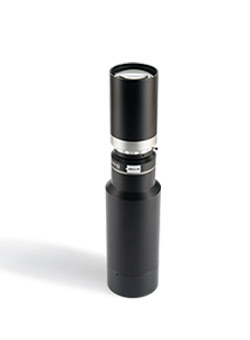Introduction to Industry Lens Selection and Classification
(2021年10月04日)https://www.canrilloptics.com/introduction-to-industry-lens-selection-and-classification.html
Introduction to Industry Lens Selection and Classification
According to optical characteristics, industry lens can be divided as: fixed focus lens, zoom lens, microscope zoom lens, and telecentric lens.
Ⅱ. Industry lens technology
1. Optical magnification
Optical magnification describes the degree of convergence or divergence of light rays passing through the lens, and the ratio of the imaging size to the actual size of the object.
Optical magnification = image size / actual object size = CCD size / field of view
E.g:
For the lens used on a 1/2" (6.4mmx4.8mm) camera, the imaging range (lateral) is actually 64mm, so the optical magnification of this lens is 6.4mm/64mm, which is 0.1x.
2. Focal length
The focal length refers to the distance from the optical center of the lens (post-optical main point) to the focal point of the imaging surface. After passing through the lens, the parallel light converges at a point, which is the so-called focal point. It is an important performance indicator of the lens. The length of the focal length determines the working distance, imaging size, field of view and depth of field for shooting. The focal lengths of commonly used lenses are 8mm, 12mm, 16mm, 25mm, 35mm, 50mm (75mm).
3. Working distance
Working distance refers to the distance from the first surface of the lens to the object to be imaged. Generally, the working distance of the lens is within a range.
4. Visual field
The lens projects the measured object and its surrounding environment on the camera's image sensor plane, forming a rectangular imaging surface on the image, and the object plane corresponding to the image in the imaging surface is called the visual field.
5. Depth of field
When the lens is sharply focused on an object, it can form a fairly clear image on the image sensor. A certain range of points in front of and behind the axis of the lens on this plane can also form clearer image points. The distance between the two planes is called the depth of field.
6. Field of view
In the optical system, with the lens as the vertex, the angle formed by the two edges of the maximum imaging range of the measured object passing through the lens is called the field of view. The size of the field of view determines the field of view of the lens. The larger the field of view is, the larger the visual field is and the smaller the optical magnification is.
7. Relative aperture
Aperture is a device inside the lens used to control the amount of light passing through the lens and entering the camera chip. The relative aperture refers to the ratio of the entrance pupil diameter to the focal length of the lens (WD/f), which is usually expressed as 1:1.4, 1:1.8, 1:2.0, etc.
8. Aperture scale
Aperture factor is an important internal parameter of the lens. It is the reciprocal of the relative aperture of the lens (f/WD). The larger the nominal value of the aperture scale is, the smaller the actual aperture will be. Generally, lens manufacturers will use the letter F to represent this parameter, and the size of F is usually set by changing the size of the aperture adjusting ring.
9. Optical size
Generally, it refers to the largest image sensor size (diagonal) that can be adapted during lens design, which is described in terms of sensor size, such as 1", 2/3”, 1/2", 1/3", etc. If the sensor size of the camera is larger than the maximum size of the lens design, dark shadows or black corners will be seen at the four corners of the screen.
10. Optical interface
The connection between the camera and the lens is the optical interface of the lens, and the industry has formed a standard specification for the optical interface. For example, CS interface, C interface and F interface. The CS interface can be converted to C interface, but C interface cannot be converted to CS interface. F is a Nikon buckle. In industrial applications, the C interface and CS interface are generally used on small sensor cameras, and the F interface is used on large sensor cameras. In addition, there are commonly used interfaces like M42, M58, M72 for line cameras... As the names suggest, these are threaded ports of a certain diameter.
11. Distortion
Distortion is actually the general term for the inherent perspective distortion of an optical lens, that is, the distortion caused by perspective. This distortion is very unfavorable to the image quality of the photo. This is the inherent characteristic of the lens, so it cannot be eliminated but can only be improved.
12. Circle of confusion
When light rays with parallel optical axes enter the lens, the ideal lens should be where all the light rays are gathered at one point and then spread out in a cone shape. This point where all the light rays are gathered is called the focal point. In front of and behind the focus, the light begins to gather and diffuse, and the image of the point becomes blurred, forming an enlarged circle. This circle is called the circle of confusion.
13. Resolution ratio/Resolving power
Lens resolution ratio, also known as resolution power and resolving power, refers to the ability of the lens to clearly reproduce the details of the subject. The resolution ratio of the lens refers to the number of pairs of black and white lines that can be distinguished within 1mm on the imaging plane, d is the line width, and its resolution ratio is 1/(2d), the unit is "line pairs/mm", for example, the resolution ratio of a certain lens is 120lp/mm.
14. MTF (Modulation Transfer Function)
Different MTF values at the same frequency bring different images.
Canrill Optics is a professional optical lens manufacturer, we provide telecentric design, telecentric lens design, camera lens selection and etc. Want to know more? Please contact us.
- このできごとのURL:






コメント